Content {#1649
#table: "cms_pages_contents"
#cleaned: array:8 [
0 => "redirect"
1 => "description"
2 => "short_description"
3 => "image_url"
4 => "alt_image_url"
5 => "icon"
6 => "scripts_head"
7 => "scripts_body"
]
#is_home: false
#public_image_paths: null
+relations_list: array:7 [
0 => "image"
1 => "alt_image"
2 => "tags"
3 => "gallery"
4 => "showcases"
5 => "forms"
6 => "forms_values"
]
#morphClass: "Content"
+content_updated: false
#searchableColumns: array:4 [
"title" => 20
"description" => 20
"short_description" => 10
"forms_values.value" => 15
]
#guarded: array:1 [
0 => "_token"
]
#auto_author: false
#auto_sequence: false
#throwValidationExceptions: true
#connection: null
#primaryKey: "id"
#keyType: "int"
#perPage: 15
+incrementing: true
+timestamps: true
#attributes: array:40 [
"id" => 478
"page_id" => 297
"parents_id" => null
"lang_code" => "en"
"layout" => "layouts.storie_root"
"title" => "Stories"
"slug" => "stories"
"url" => "stories"
"status" => "published"
"description" => ""
"short_description" => null
"image_url" => "/cms-contents/uploads/119487660-816357045768456-917241413732078086-n.jpg"
"alt_image_url" => ""
"icon" => "/cms-contents/uploads/logo-storie.png"
"contact_id" => null
"redirect" => ""
"no_website_title" => "0"
"no_sitemap" => 0
"meta_no_index" => 0
"meta_no_follow" => 0
"meta_title" => "Stories"
"meta_keywords" => null
"meta_description" => ""
"canonical" => null
"scripts_head" => ""
"scripts_body" => ""
"custom_slug" => 0
"custom_short_description" => 0
"custom_meta_title" => 0
"custom_meta_keywords" => 0
"custom_meta_description" => 0
"custom_canonical" => 0
"is_custom" => 0
"publish_start" => "2020-11-20 12:46:03"
"publish_end" => "0000-00-00 00:00:00"
"created_at" => "2020-11-27 17:47:13"
"updated_at" => "2021-09-22 19:00:34"
"changefreq" => "weekly"
"uid_import" => null
"uid_checksum" => null
]
#original: array:40 [
"id" => 478
"page_id" => 297
"parents_id" => null
"lang_code" => "en"
"layout" => "layouts.storie_root"
"title" => "Stories"
"slug" => "stories"
"url" => "stories"
"status" => "published"
"description" => ""
"short_description" => null
"image_url" => "/cms-contents/uploads/119487660-816357045768456-917241413732078086-n.jpg"
"alt_image_url" => ""
"icon" => "/cms-contents/uploads/logo-storie.png"
"contact_id" => null
"redirect" => ""
"no_website_title" => "0"
"no_sitemap" => 0
"meta_no_index" => 0
"meta_no_follow" => 0
"meta_title" => "Stories"
"meta_keywords" => null
"meta_description" => ""
"canonical" => null
"scripts_head" => ""
"scripts_body" => ""
"custom_slug" => 0
"custom_short_description" => 0
"custom_meta_title" => 0
"custom_meta_keywords" => 0
"custom_meta_description" => 0
"custom_canonical" => 0
"is_custom" => 0
"publish_start" => "2020-11-20 12:46:03"
"publish_end" => "0000-00-00 00:00:00"
"created_at" => "2020-11-27 17:47:13"
"updated_at" => "2021-09-22 19:00:34"
"changefreq" => "weekly"
"uid_import" => null
"uid_checksum" => null
]
#relations: []
#hidden: []
#visible: []
#appends: []
#fillable: []
#dates: []
#dateFormat: null
#casts: []
#touches: []
#observables: []
#with: []
+exists: true
+wasRecentlyCreated: false
-order_dict: array:2 [
"+" => "ASC"
"-" => "DESC"
]
}

: 05/03/2021
Orfeo Piccoli
Latteria Sociale di Trissino produces Asiago Stagionato PDO in its plant in the province of Vicenza.
ORFEO PICCOLI: THE IMPORTANCE OF TRADITION
Orfeo Piccoli has been a cheesemaker in Trissino for four years, and every day he transforms the milk from local farms into Asiago Stagionato cheese.
For him, this job means most of all carrying on the tradition and culture of cheesemaking. With his work, he writes a new chapter in the story of a delicious and authentic symbol of the place he loves. A product that every day, in his capable hands, showcases the unique characteristics of fresh raw milk.
For him, this job means most of all carrying on the tradition and culture of cheesemaking. With his work, he writes a new chapter in the story of a delicious and authentic symbol of the place he loves. A product that every day, in his capable hands, showcases the unique characteristics of fresh raw milk.

“I’m proud to be a cheesemaker, and to carry on the cheesemaking tradition of Veneto. My work tells the story of a symbolic product from this region.”
“It comforts the soul, to look up and see the hill standing out in silhouette against the luminous background of the Prealps of Vicenza. For those who gaze upon it from afar, it is a dreamlike vision of incomparable beauty. For those who observe it closely, it is like an elaborate crèche, full of villas and cottages surrounded by gardens. To walk its narrow, winding streets is to find oneself in a peaceful and bucolic world.”
Giuliano Menato
Trissino is a small town located at the edge of the Valle dell’Agno valley in the province of Vicenza. Its name is probably derived from “Dripsinum,” the name of a village belonging to the Dripsinates people in Roman times.
Giuliano Menato
Trissino is a small town located at the edge of the Valle dell’Agno valley in the province of Vicenza. Its name is probably derived from “Dripsinum,” the name of a village belonging to the Dripsinates people in Roman times.
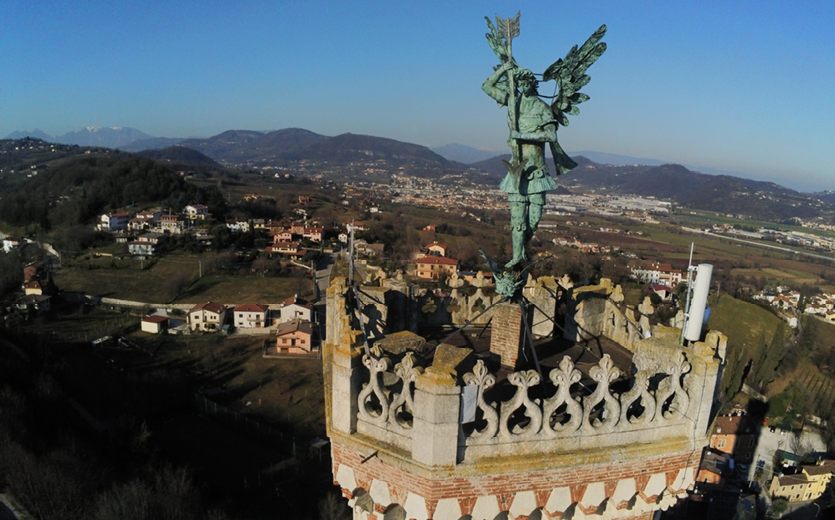
Archaeological digs between 1980 and 1990 revealed a significant Iron Age settlement beneath the modern-day cemetery. Discovering made during those expeditions showed that Trissino dates back to the 5th-6th century BC and was inhabited by Paleovenetian-Rhaetian subalpine populations. The word “Dresseno” first appears in the “Paduan Diplomatic Codex,” where in a document dated 1090, January 6, it is attested that Joannes de Dresseno makes a gift of three farms, located in Camisano, to a monastery of Padua. In another later document, dated 1175, the expression “de Dresseno” reappears, referring to the Vicenza nobleman Uldericus.
In the era of the Roman republic “Dresseno,” was part of the Province of Cisalpine Gaul and, under Augustus, of the Decima Regio. In the Middle Ages it probably suffered the fate of many pre-Alpine villages in the Vicenza area, until the appearance of the noble family Trissino in the 12th century. The family indeed took its name from “Dresseno,” the place where it settled and established its lands.
Over the following centuries, the town’s fortunes followed that of the family, often fighting for predominance, and the Padovani, Scaglieri and Visconti families also passed through the area. In the early years of the fifteenth century Trissino, like the whole territory of Vicenza, was ruled by the Republic of Venice, and in it 1409 it formulated its first Municipal Statute, which collected laws and rules that regulated the civil and administrative life of the town for a long time.
Over the following centuries, the town’s fortunes followed that of the family, often fighting for predominance, and the Padovani, Scaglieri and Visconti families also passed through the area. In the early years of the fifteenth century Trissino, like the whole territory of Vicenza, was ruled by the Republic of Venice, and in it 1409 it formulated its first Municipal Statute, which collected laws and rules that regulated the civil and administrative life of the town for a long time.
After the Treaty of Campoformio (1797), with the fall of the Venetian Republic, it was ruled first by the French and then by the Austrians until the Third War of Independence, when the Veneto was annexed to the Kingdom of Italy in 1866.
Although the town is small, it contains many noteworthy works of art and architecture, including the Parish Church of St. Andrew, built in 1530, and the Villa Trissino Marzotto, a monumental complex consisting of an upper and lower villa. After numerous architectural changes dating from 1400 to 1800, it is now one of the most beautiful residences in the Vicenza area.
Although the town is small, it contains many noteworthy works of art and architecture, including the Parish Church of St. Andrew, built in 1530, and the Villa Trissino Marzotto, a monumental complex consisting of an upper and lower villa. After numerous architectural changes dating from 1400 to 1800, it is now one of the most beautiful residences in the Vicenza area.
ASIAGO: FROM PEGORIN TO PDO
The story of the origins of Asiago cheese is lost deep in the history of the peoples of the Asiago Plateau, from where it takes its name. Its invention is traditionally dated to around the year 1000, since the first verified historical records of it are found around this date, even though many claim the cheese was invented far earlier.
In the plateau of the Sette Comuni, the soil was fertile and the grass was good. Sheep farming was the main industry, thanks to which a tasty cheese was produced from sheep's milk, pegorin.
With the modernization of the techniques, around 1500, cattle ranching gradually began to replace sheep farming. Cheese-making technique was remarkably refined and transferred to the small and medium cheese factories scattered across the production area.
In the plateau of the Sette Comuni, the soil was fertile and the grass was good. Sheep farming was the main industry, thanks to which a tasty cheese was produced from sheep's milk, pegorin.
With the modernization of the techniques, around 1500, cattle ranching gradually began to replace sheep farming. Cheese-making technique was remarkably refined and transferred to the small and medium cheese factories scattered across the production area.
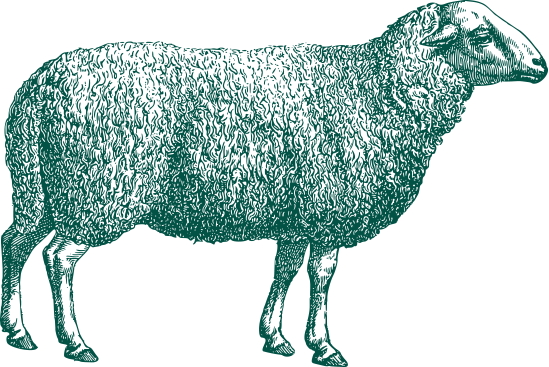
The production of Asiago cheese, prevalent since the mid-nineteenth century on the plateau of the same name, gradually spread to the foothills, to the surrounding plains and to the nearby mountain pastures of Trentino. The main cause of this spread was the depopulation of the Altopiano dei Sette Comuni, due to the use of the plateau as a front during the First World War. At that time, only Asiago d’allevo was produced, and its forms, fragrant according to traditional processing and maturation, were cut after months of aging.
In the 1920s, on the other hand, the production of a shorter-aged Asiago cheese, called Asiago pressato, began. In this style, forms are pressed under manual or hydraulic presses as soon as they are produced.
In the 1920s, on the other hand, the production of a shorter-aged Asiago cheese, called Asiago pressato, began. In this style, forms are pressed under manual or hydraulic presses as soon as they are produced.
In 1955 Asiago cheese obtained the Typical Denomination and then, on 21 December 1978, the Protected Denomination of Origin.
In 1979 the “Consortium for the protection of Asiago cheese” was founded, created by 56 member dairies to safeguard the characteristics of cheese production, while improving the quality and quantity of the cheese.
Today Asiago is the fourth PDO cow's milk cheese in Italy in terms of quantity produced.
In 1979 the “Consortium for the protection of Asiago cheese” was founded, created by 56 member dairies to safeguard the characteristics of cheese production, while improving the quality and quantity of the cheese.
Today Asiago is the fourth PDO cow's milk cheese in Italy in terms of quantity produced.
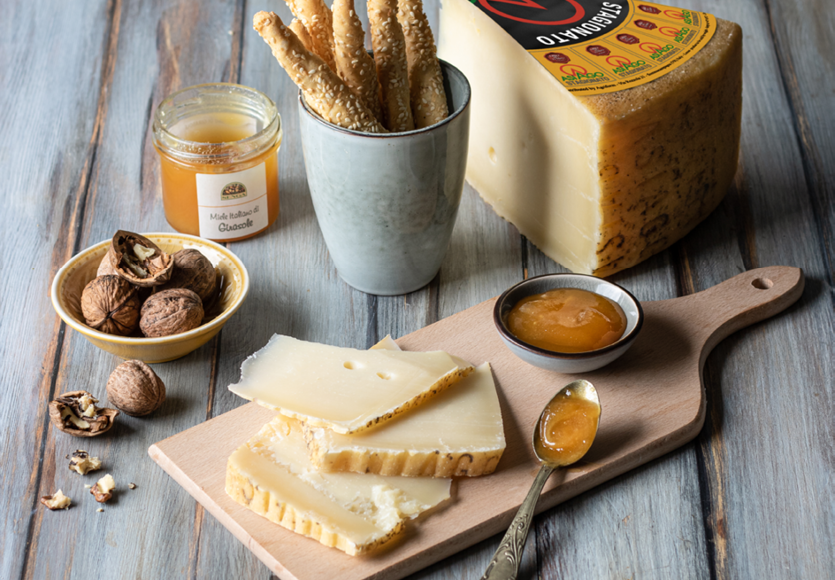
ASIAGO STAGIONATO: A BOLD AND ELEGANT TASTE
Asiago Stagionato cheese, also called Asiago d’allevo, is made with part-skim milk and aged for at least 3, sometimes over 15 months.
Straw-colored, dense and with scattered small- to medium-sized eyes, it is boldly flavorful with pleasant mildly-spicy notes. Its aroma recalls bread dough, almonds, and hazelnuts.
The artisanal production of this cheese depends on methods that have been passed down from generation to generation.
After thermization, calf rennet and selected cultures are added to the milk to begin the coagulation and cheesemaking process.
The curd that forms is then cut into hazelnut-sized pieces with a tool called a “spino.” It is semi-cooked at a temperature of 47°C, removed from the vat and placed in a round mold, ready to receive its identifying markings.
The cheese is left to rest for at least two days at a controlled temperature and relative humidity and is then either dry-salted or brined.
Straw-colored, dense and with scattered small- to medium-sized eyes, it is boldly flavorful with pleasant mildly-spicy notes. Its aroma recalls bread dough, almonds, and hazelnuts.
The artisanal production of this cheese depends on methods that have been passed down from generation to generation.
After thermization, calf rennet and selected cultures are added to the milk to begin the coagulation and cheesemaking process.
The curd that forms is then cut into hazelnut-sized pieces with a tool called a “spino.” It is semi-cooked at a temperature of 47°C, removed from the vat and placed in a round mold, ready to receive its identifying markings.
The cheese is left to rest for at least two days at a controlled temperature and relative humidity and is then either dry-salted or brined.
The last phase is aging. The cheese must be aged for at least three months, in its region of origin, in facilities with controlled storage temperatures and relative humidity.
Depending on how long it is aged, it can be called Asiago Mezzano (4 to 6 months), Asiago Vecchio (10 to 15 months) or Asiago Stravecchio (over 15 months).
The production of Asiago cheese is subject to the protections of PDO classification, and must take place in the provinces of Vicenza, Trento, and the bordering areas of the provinces of Padua and Treviso.
DISCOVER ASIAGO STAGIONATO DOP
Depending on how long it is aged, it can be called Asiago Mezzano (4 to 6 months), Asiago Vecchio (10 to 15 months) or Asiago Stravecchio (over 15 months).
The production of Asiago cheese is subject to the protections of PDO classification, and must take place in the provinces of Vicenza, Trento, and the bordering areas of the provinces of Padua and Treviso.
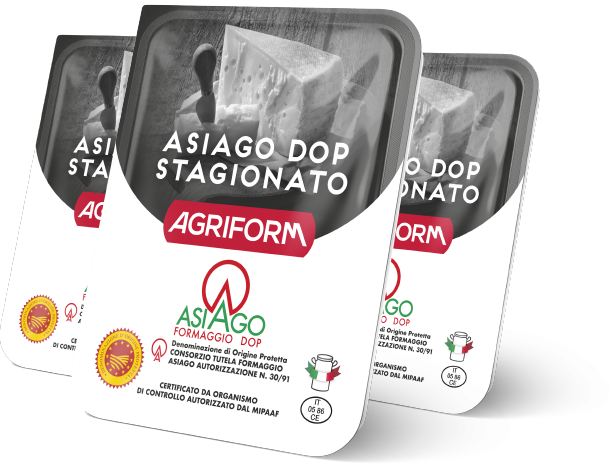
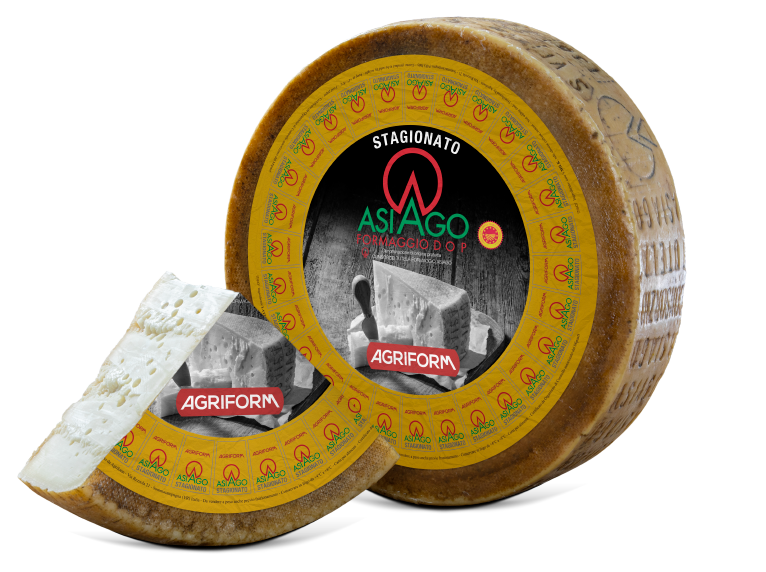
SAFELY, ALL OVER THE WORLD
In response to growing local and international market demand, in 2002 the first packaging center was created in Sommacampagna.
11 lines for production of over a thousand pieces, with cutting-edge machinery.
And that’s where the Asiago Stagionato process ends: the cheese is portioned and vacuum-packed, in a protective atmosphere or in thermoformed packaging,
but not before undergoing careful checks that guarantee its safety and freshness for the end consumer.
Finally, thanks to the company's extensive sales network, it is distributed worldwide.
11 lines for production of over a thousand pieces, with cutting-edge machinery.
And that’s where the Asiago Stagionato process ends: the cheese is portioned and vacuum-packed, in a protective atmosphere or in thermoformed packaging,
but not before undergoing careful checks that guarantee its safety and freshness for the end consumer.
Finally, thanks to the company's extensive sales network, it is distributed worldwide.
